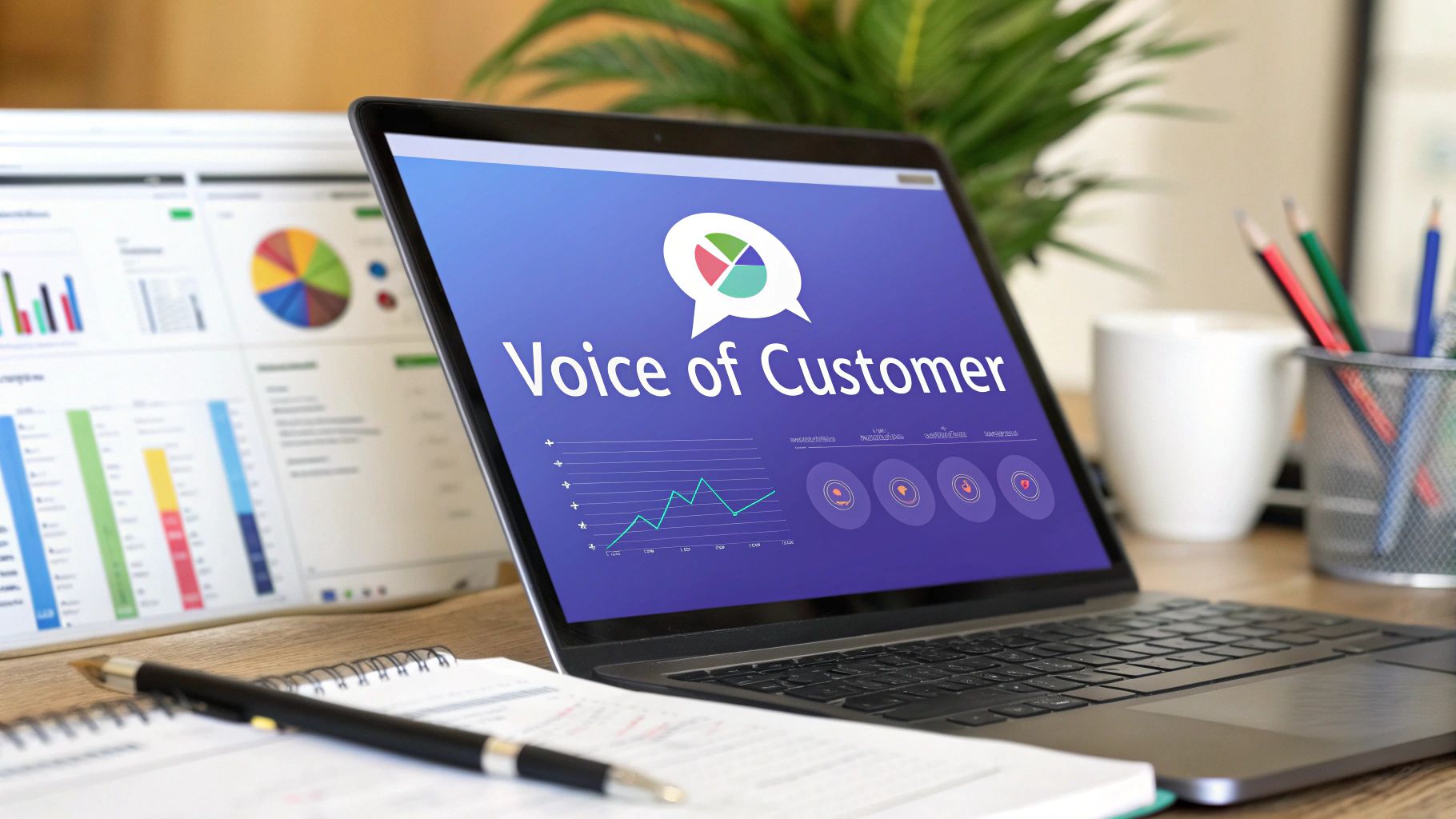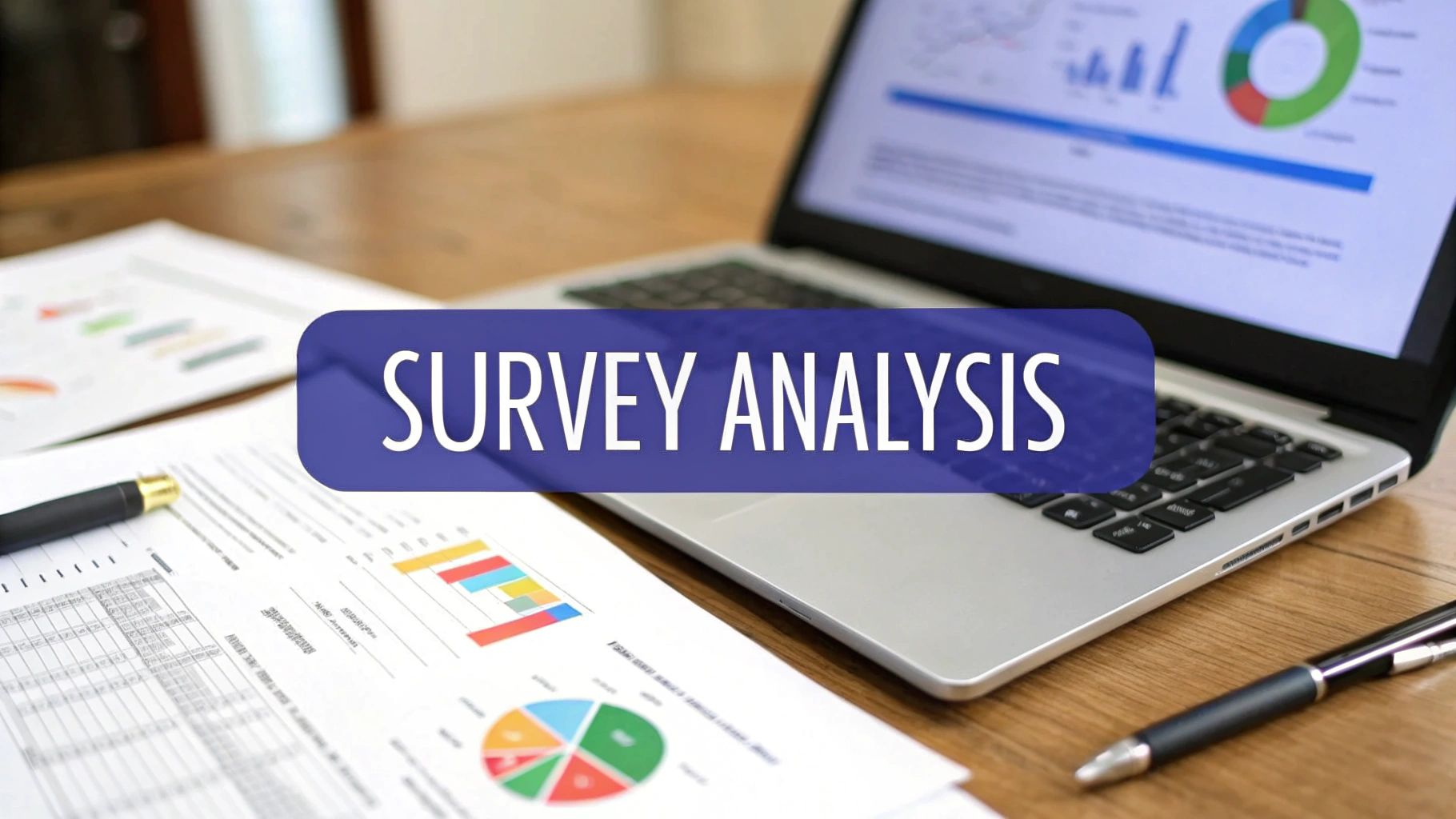Churn Rate SaaS: Strategies to Improve Customer Retention
Learn how to analyze and optimize your churn rate SaaS. Discover proven methods to reduce customer loss and boost growth effectively.
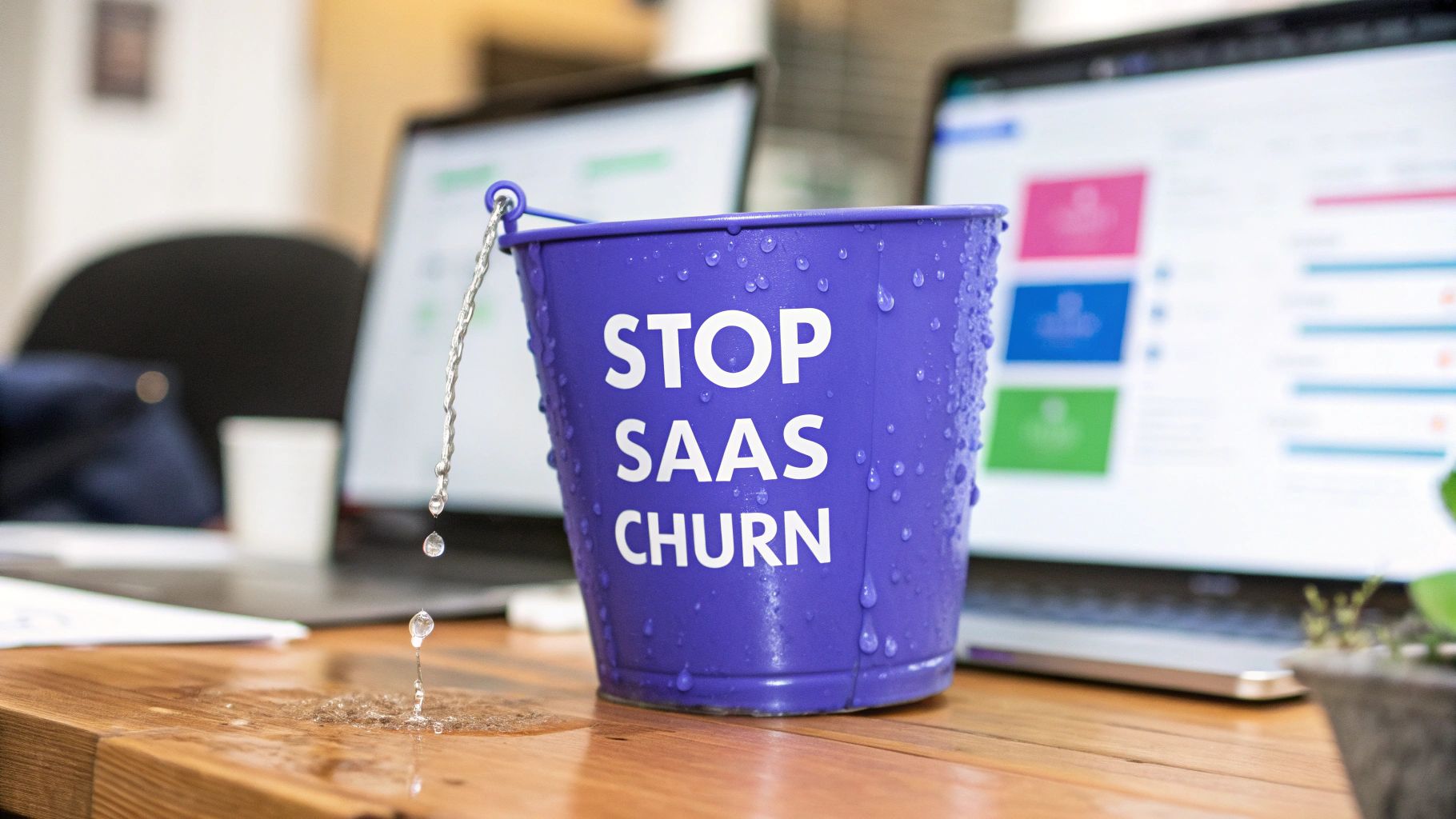
If you're in the SaaS industry, you've heard the term "churn." What exactly is it, and why does it keep founders and growth marketers up at night?
SaaS churn rate is the percentage of customers who cancel their subscriptions within a specific timeframe. It's a direct measure of how many users you're losing. This makes it one of the most important vital signs for the health and sustainability of your business.
What Is SaaS Churn and Why Does It Matter?
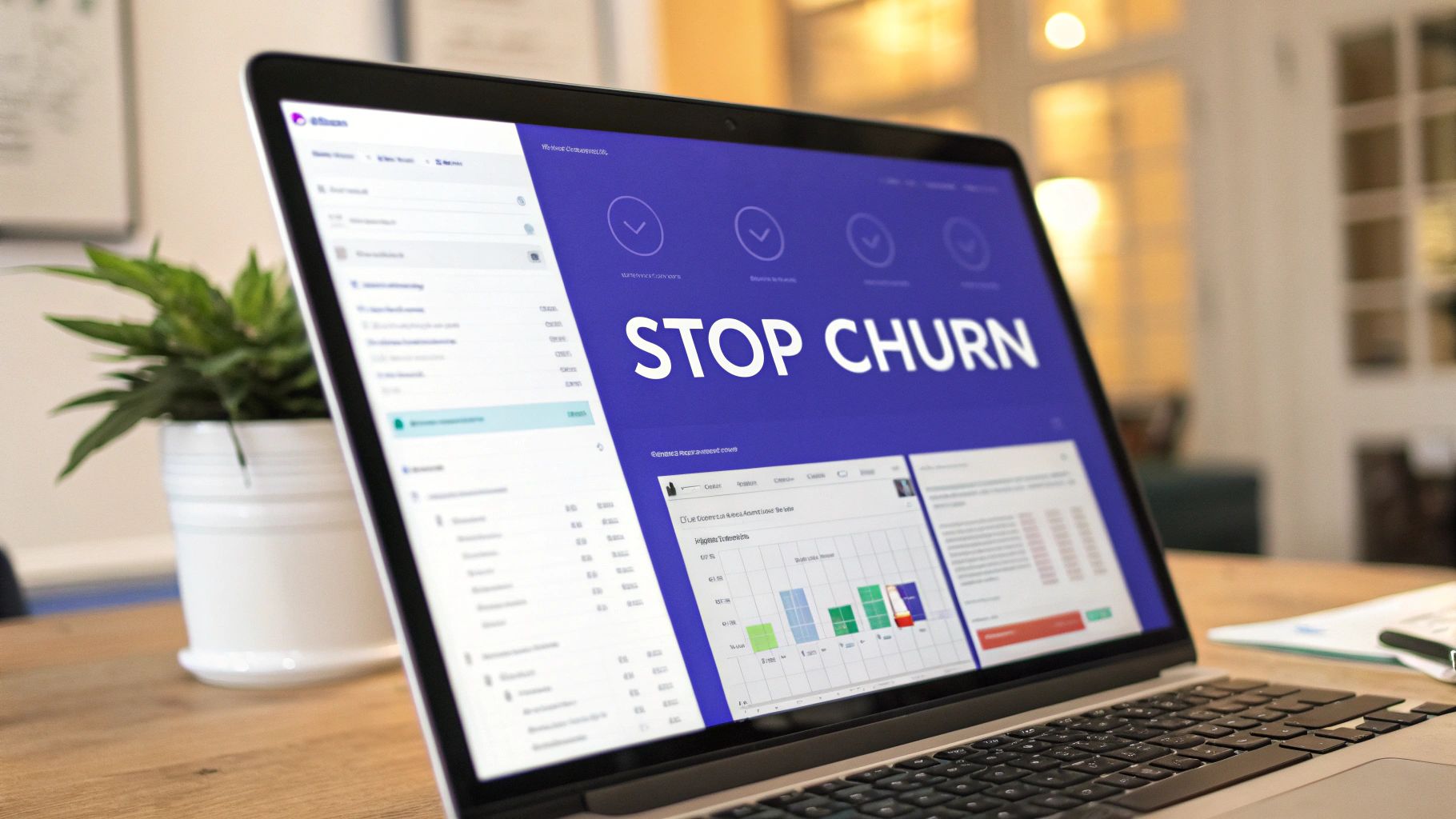
Think of your business as a bucket you're constantly trying to fill with water. New customers are the water flowing in from the top. Churn is the hole in the bottom of the bucket. No matter how aggressively you pour water in, you’ll never fill it up if you don't plug the leaks.
This simple analogy captures the challenge of managing your SaaS churn rate.
A high churn rate is a massive red flag. It’s a clear signal that something isn’t right. Maybe your product isn't hitting the mark, your customer support is falling short, or a competitor is doing a better job of solving your customers' problems. At its core, churn is a direct reflection of customer satisfaction and the value they get from your product.
Why Every SaaS Team Should Obsess Over Churn
Ignoring churn is one of the quickest ways to silently sabotage your own growth. While celebrating new customer acquisition is great, holding onto the customers you have is far more profitable and efficient. Keeping an existing customer is almost always cheaper than acquiring a new one.
This focus on retention has a huge impact on your bottom line. Globally, the SaaS industry sees an average annual churn rate between 5% and 7%. Even a tiny improvement can lead to massive gains; a modest 5% reduction in churn can boost profitability by as much as 95%. You can learn more about how key SaaS statistics impact business growth right here.
This is why managing your SaaS churn rate is a core business function. It affects everything from revenue projections to investor confidence.
A low churn rate tells you that your customers are happy, they see value in your product, and they're likely to stick around. It’s one of the best indicators of a strong product-market fit and a solid retention strategy.
Understanding the Two Faces of Churn
It’s also important to know that churn isn't a one-size-fits-all metric. It comes in two main flavors, and each one tells a different story about your business.
Customer Churn: This is the most straightforward type. It measures the percentage of customers who cancel their service entirely. If you start a month with 100 customers and 5 leave, your customer churn is 5%. Simple as that.
Revenue Churn: This one tracks the percentage of monthly recurring revenue (MRR) you've lost from existing customers. It’s a more complete financial picture because it accounts for cancellations, downgrades, and upgrades.
Keeping an eye on both gives you a much richer view of your business's health. For example, you might have low customer churn but high revenue churn if your biggest, highest-paying accounts are the ones leaving. Recognizing this distinction is the first step to building a real strategy to keep your customers happy, engaged, and subscribed for the long haul.
To help you keep these key ideas straight, here's a quick reference table.
Core SaaS Churn Concepts at a Glance
Knowing these concepts is fundamental to building a SaaS business that not only grows but lasts.
How to Accurately Calculate Your Churn Rate
Calculating your churn rate is like taking your company's pulse. You need a clear, honest look at your health, which means knowing exactly how many customers are walking away and what financial hole they're leaving behind.
This all starts with two different but equally important calculations: customer churn and revenue churn. One tells you a story about volume, while the other gets straight to the impact on your bottom line.
Calculating Customer Churn
Customer churn is the most direct way to measure your SaaS churn rate. Think of it as a simple headcount. It tracks the percentage of customers who decide to cancel their subscriptions over a specific period.
To figure out your customer churn rate, you only need two pieces of information:
- How many customers you had at the start of the period (say, a month).
- How many of those customers canceled during that same month.
The formula is as simple as it gets:
(Customers Lost During Period ÷ Customers at Start of Period) x 100 = Customer Churn Rate %
Let's say you started the month with 500 customers and 25 of them canceled. The math would be: (25 ÷ 500) x 100 = 5%. Just like that, you know your monthly customer churn rate is 5%. While it's a basic metric, it’s a surprisingly powerful signal of your overall customer satisfaction.
If you want to learn more, you can explore more detailed methods in our complete guide to calculating churn rate.
This infographic gives you a quick visual breakdown of the basic steps.
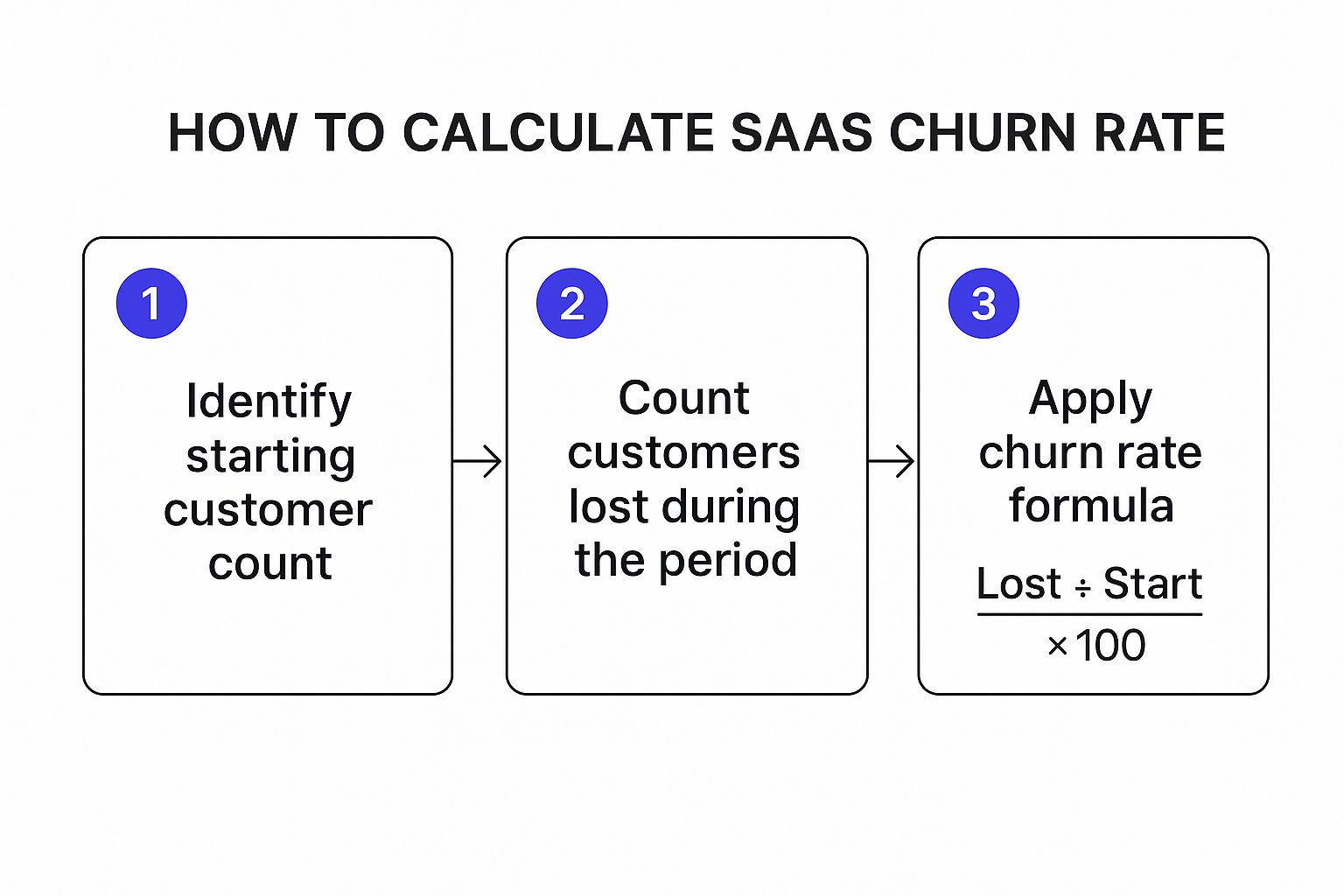
As you can see, it really is a direct, three-step process: count your customers, tally the losses, and plug the numbers into the formula.
Understanding Revenue Churn
While customer churn tracks the logos you've lost, revenue churn tracks the dollars. This metric shows you the percentage of monthly recurring revenue (MRR) you’ve lost from existing customers in a given period. It paints a much clearer picture of your financial stability.
Why is this so important? Because not all customers have the same financial weight. Losing one enterprise client who pays $10,000/month hits a lot differently than losing ten small businesses paying $50/month each. Customer churn might see those scenarios as similar, but revenue churn exposes the real financial damage.
Revenue churn doesn't just look at full cancellations. It also accounts for:
- Cancellations: The total MRR you lose when customers leave for good.
- Downgrades: The MRR you lose when customers switch to a cheaper plan.
Here’s the formula to calculate it:
(MRR Lost to Churn & Downgrades ÷ MRR at Start of Period) x 100 = Revenue Churn Rate %
Imagine you began the month with $100,000 in MRR. Over that month, you lost $5,000 from cancellations and another $2,000 from customers downgrading their plans. Your total MRR loss is $7,000.
Your revenue churn rate would be: ($7,000 ÷ $100,000) x 100 = 7%.
Just as you need to track what you're losing, it's smart to look at what you're keeping. For a different but complementary angle, check out this guide on mastering your customer retention rate calculation.
By keeping a close eye on both customer and revenue churn, you get the full picture. You see not just who is leaving, but what their departure truly costs your business.
SaaS Churn Rate Benchmarks You Should Know
So, you've calculated your SaaS churn rate. Now what? The next question on every founder's mind is, "Is my number any good?"
A 5% churn rate might sound fantastic or terrifying. It all depends on the context. Without a frame of reference, your churn metric is just a number floating in a vacuum, telling you nothing about your actual performance.
To get some real perspective, you need to look at industry benchmarks. These numbers give you a feel for what’s typical for SaaS businesses of different sizes and in different markets. Comparing your rate to these benchmarks helps you set realistic goals and see if you’re keeping up with the pack.
Why Company Size Matters for Churn
Not all SaaS companies face the same retention challenges. A scrappy startup’s churn rate will naturally look different from an established enterprise player’s. That’s often tied directly to size and market maturity.
For SaaS businesses pulling in less than $10 million in annual revenue, the median annual churn rate hovers around 20%. This reflects the rough reality of early-stage growth, where you're still nailing down product-market fit. In contrast, larger firms with over $10 million in revenue see much lower churn, averaging about 8.5% a year. You can dig into more SaaS stats over at 99firms.com.
This gap makes perfect sense when you think about it. Early-stage companies are still experimenting, often attracting a wide net of customers who aren't all a perfect long-term fit. Established companies have had time to zero in on their ideal customer and build a stickier, more indispensable product.
Churn Rates for SMB vs. Enterprise Customers
Who you sell to is another massive piece of the puzzle. As a general rule, companies that sell to Small and Medium-Sized Businesses (SMBs) will almost always have higher churn than those selling to big enterprise clients.
There are a few solid reasons for this:
- Lower Switching Costs: It’s way easier for a small business to ditch one tool for another. They don’t have layers of bureaucracy or hundreds of employees to retrain on a new platform.
- Budget Sensitivity: SMBs run on tighter margins. When it's time to cut costs, SaaS subscriptions are often the first to go.
- Business Volatility: Small businesses are just plain riskier. They’re more likely to go under or pivot, making their customer lifetime less predictable.
Enterprise clients are notoriously sticky. Adopting a new platform can mean months of implementation, complex data migration, and retraining an entire workforce. This creates a powerful "moat" that makes them far less likely to churn.
Because of this, a 3-5% monthly churn rate might be perfectly acceptable for a SaaS company focused on SMBs. But if you’re serving enterprise clients, you should be aiming for a churn rate well below 1% per month.
How Industry Verticals Influence Churn
Finally, the industry you're in matters. A lot. Different sectors have unique market dynamics and customer expectations, all of which shape what a "normal" churn rate looks like. A B2C streaming service, for example, is going to have a much higher churn rate than a B2B financial compliance tool that’s deeply embedded in a company’s operations.
To give you a clearer picture, here’s a quick look at how typical monthly churn rates can differ across various SaaS sectors.
Typical Monthly Churn Rates by SaaS Industry
This table offers a general comparison of average monthly churn rates, showing just how much your industry context matters when evaluating your own numbers.
Knowing these benchmarks gives you a realistic baseline. It stops you from panicking over a 4% churn rate if you’re serving SMBs in a competitive space. It also signals there’s room to improve if your enterprise churn is creeping up to 2%.
The Most Common Reasons Customers Leave

If you really want to bring your SaaS churn rate down, you first have to figure out why your customers are walking out the door. Churn is almost never a random event. Think of it as a symptom of a much deeper problem.
Once you start pinpointing the root causes, you can shift from watching a number go up to fixing the issues driving people away. Most SaaS businesses find that a handful of common problems are behind the majority of their churn. Let’s look at what they are.
A Poor Onboarding Experience
Those first few days and weeks a customer spends with your product are make-or-break. A confusing, clunky, or unguided onboarding process is one of the biggest reasons for early churn. If users can't figure out how to get value from your tool, and fast, they’ll lose patience and start looking for another solution.
This is especially true for more complex software. People don't sign up to read a dense manual; they sign up to solve a problem. Your onboarding should be a guided tour that leads them straight to that first "aha!" moment, where the product's value clicks for them.
Customers don’t churn because they fail to understand every single feature. They churn because they fail to get the results they were hoping for. A strong onboarding process connects features directly to those desired outcomes.
Lack of Perceived Value
Customers will keep paying for a service as long as they believe its value outweighs its cost. The second that equation flips, they start looking for the cancel button. This "value gap" can pop up for a few reasons.
Sometimes, the customer was never the right fit for your product to begin with. Other times, the product fails to deliver on its marketing promises. It can also happen when a customer’s needs evolve and your tool no longer solves their most urgent problems. You have to continuously demonstrate value through new features, helpful content, and proactive support to keep this from happening.
Ineffective Customer Service
When a customer hits a snag, your support team is their lifeline. Slow, unhelpful, or hard-to-reach customer service is a massive source of frustration. In fact, a staggering 67% of customer churn could reportedly be prevented if the customer's issue was resolved during that first interaction.
Great support is about more than squashing bugs. It's about showing customers you're genuinely invested in their success. It only takes one bad support experience to erase months of goodwill and push a customer to leave for good.
Pricing and Perceived Cost
Your pricing model has a direct line to your SaaS churn rate. If customers feel the price is too high for what they're getting, they will churn. This often becomes an issue when a company raises its prices without adding significant new features or clear benefits.
It's also important to offer flexible plans. A rigid, one-size-fits-all pricing structure might force a growing company to look elsewhere for a solution that better suits their budget and needs. Transparent pricing and clear communication around any changes are non-negotiable for maintaining trust.
A Superior Competitor Offering
The SaaS market is crowded. You can bet your customers know who your competitors are and what they offer. If a competitor rolls out a groundbreaking feature, offers a much better price, or creates a slicker user experience, some of your customers are going to jump ship.
This is exactly why you can't afford to stand still. You have to constantly keep an eye on the market, listen to what your customers are asking for, and never stop improving your product. Staying competitive is not just about landing new customers; it's about giving your existing ones no reason to look elsewhere.
Actionable Strategies to Reduce Customer Churn

Knowing why customers are leaving is one thing. Doing something about it is what will move the needle on your SaaS churn rate. By putting a few proven strategies into play, you can shift from reacting to retention problems to proactively building a stickier product that customers won't want to leave.
These tactics aren't random shots in the dark. They focus on improving the moments that matter most in the customer journey, from the first time they log in to their ongoing experience. Success here is about getting ahead of churn before it even happens.
Perfect the Customer Onboarding Experience
Let's be honest: the first 30 to 90 days are make-or-break. A clunky, confusing onboarding process is a one-way ticket to churn city. A smooth, guided experience lays the groundwork for a long and happy relationship.
If new users can get a quick win and see your product's value early on, they're far more likely to stick around for the long haul.
Your goal isn't to throw every single feature at them at once. That's just overwhelming. Instead, your job is to guide them straight to their first "aha!" moment, the point where they solve the exact problem they hired your product to fix.
Here’s how you can nail your onboarding:
- Create guided product tours: Use simple in-app messages to walk new folks through the most important first steps.
- Track key activation milestones: Figure out what your most successful users do early on, and then gently nudge new sign-ups to do the same.
- Offer personalized support: Have an onboarding specialist reach out, or use automated check-ins to help anyone who seems stuck.
Implement Proactive Customer Success Check-Ins
Don't wait around for customers to raise their hands and tell you they're unhappy. Proactive customer success is all about reaching out before things go south. By keeping an eye on user behavior, you can spot the early warning signs of churn and step in to help.
What are those warning signs? Look for things like a sudden drop in product usage, a decline in adopting new features, or a spike in support tickets. When you see these trends, it's go-time for your customer success team.
Churn rarely happens overnight. It's usually the result of a series of small frustrations or a slow decline in engagement. Proactive check-ins can catch these issues while they're still small enough to fix.
A simple check-in can be a friendly email asking how things are going or an offer to jump on a quick call to share some best practices. It shows you're invested in their success, not just their monthly subscription payment.
Build Effective Feedback Loops with Surveys
You can't fix problems you don't even know exist. Building systematic feedback loops is the best way to keep a finger on the pulse of how your customers are feeling. Surveys are a fantastic tool for this, but they need to be targeted and sent at the right time.
There are a few types of surveys that are especially powerful for managing your SaaS churn rate:
- Net Promoter Score (NPS) Surveys: These ask that one simple question: "How likely are you to recommend us?" The answers split your users into Promoters, Passives, and Detractors, giving you a high-level view of loyalty.
- Customer Satisfaction (CSAT) Surveys: Usually sent after a support ticket is closed or a key milestone is hit, CSAT surveys measure short-term happiness with a specific interaction.
- Exit Surveys: When a customer decides to cancel, an exit survey is your last, best chance to find out why. This feedback is pure gold for spotting patterns among the customers you're losing.
The real magic, though, is acting on the data you gather. If a dozen customers all mention the same frustrating bug, that's a crystal-clear signal to get it fixed. For more inspiration, you can explore other proven methods to reduce churn with targeted strategies.
Use Product Data to Identify At-Risk Customers
Your product analytics are a treasure trove of clues about customer health. By digging into usage data, you can paint a clear picture of who is at risk of churning long before they hit the cancel button.
Look for customers who've stopped using the key features that you know correlate with long-term retention. For instance, if you know that users who create and share reports are 50% less likely to churn, then a customer who hasn't touched that feature in 60 days should set off alarm bells.
Once you've identified these at-risk segments, you can launch targeted re-engagement campaigns. This could be anything from an email highlighting a new feature they might love to an in-app message offering a quick tutorial on a part of the product they've ignored. When you let data guide your actions, your retention efforts become smarter, more effective, and much easier to scale.
Using Customer Feedback to Predict and Prevent Churn
While digging through product data can tell you what is happening, customer feedback tells you why. Think of it as an early warning system. It alerts you to problems long before they snowball into cancellations, giving you a massive head start on your SaaS churn rate.
Building a system to collect, analyze, and act on that feedback is one of the most proactive moves you can make. Instead of scrambling after a customer has already hit "cancel," you're fixing the little frustrations that push them in that direction. It's a total shift in mindset, from reactive damage control to proactive relationship building. The goal is to solve problems long before the cancel button even enters their mind.
Setting Up Your Feedback Channels
Timing is everything. You need to ask for feedback at the right moments in the customer journey to get a clear picture. Different tools work best for different situations, and combining them is how you see the full story.
Here are a few of the most effective channels for any SaaS business:
- In-App Surveys: These are gold for capturing in-the-moment feelings about a specific feature. A quick, one-question poll after a user completes a task? That’s pure, contextual insight right there.
- Email Surveys: Perfect for getting more detailed thoughts. This is where you'd run something like a Net Promoter Score (NPS) survey to gauge overall loyalty, giving customers the space to give you a thoughtful response.
- Exit Surveys: This is your last, best chance to learn from a customer who's on their way out. When someone cancels, a short, automated survey asking why gives you brutally honest, unfiltered intel on your product's biggest weaknesses.
Turning Feedback into Actionable Insights
Collecting feedback is just step one. The real magic happens when you do something with it. A mountain of raw comments and survey scores is useless without a process to turn it into clear, actionable steps for your team.
Start by tagging and categorizing everything that comes in. You’ll quickly start to see patterns. Are multiple users hitting the same bug? Is the same feature request popping up again and again? These themes are your roadmap. If 15% of your churning customers mention a confusing UI in their exit surveys, you have a clear mandate to simplify your design.
By systematically analyzing feedback, you move beyond guesswork. You can prioritize product updates and service improvements based on what customers are telling you. This helps focus your efforts on the things that will make the biggest impact on retention.
To really nail churn prevention, you have to get good at collecting valuable insights. You can explore a number of effective customer feedback strategies that will help you get started.
For even more ideas, check out our guide on how to get customer feedback that truly drives results. This kind of structured approach makes sure no comment goes to waste and that every customer's voice helps you build a stickier product.
A Few Lingering Questions About SaaS Churn
We've covered a lot of ground on the ins and outs of churn, but a few common questions always seem to pop up. Let's tackle them head-on to clear up any final confusion.
What Is Considered a Good Churn Rate?
This is the million-dollar question, and the honest answer is: it depends entirely on who you're selling to.
For SaaS companies catering to big enterprise clients, anything under 1% monthly churn is fantastic. But if your world is small to medium-sized businesses (SMBs), a churn rate between 3% and 5% per month is generally considered acceptable, even healthy. The key is to stop comparing apples to oranges and look at benchmarks for your specific customer segment.
How Often Should I Calculate Churn?
Most SaaS businesses stick to a monthly calculation. It's the sweet spot: frequent enough to catch worrying trends before they snowball, but not so frequent that you're getting lost in daily noise.
That said, it’s also smart to zoom out for a more strategic view. Calculating churn quarterly and annually will give you a much clearer picture of your long-term health.
Is It Possible to Have Negative Revenue Churn?
Absolutely, and it's the holy grail for any subscription business. Negative revenue churn happens when the extra money you make from your existing customers (think upgrades, add-ons, or cross-sells) is more than the revenue you lose from the customers who cancel or downgrade.
When you hit this milestone, it means your business can grow even without signing up a single new customer.
Reaching negative revenue churn is one of the most powerful signs of a healthy, thriving business. It proves you have a sticky product that customers love, and they're willing to invest more in it over time.
Your existing customer base basically becomes its own engine for growth.
Ready to turn customer feedback into your best retention tool? Surva.ai gives you the power to understand why customers leave and win them back with intelligent, automated surveys and churn deflection flows. Start reducing your churn rate today.

